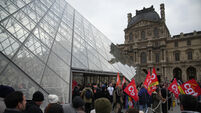Ancient document says Judas was friend of Jesus
Judas was not a traitor but a close friend of Jesus who was only doing his bidding when he turned him in with a kiss, a newly translated ancient document unveiled in the US today suggests.
The Gospel of Judas, which dates from around 300 AD and was discovered in Egypt in 1970, may shed new light on the relationship between Christ and the apostle reviled for so long.














